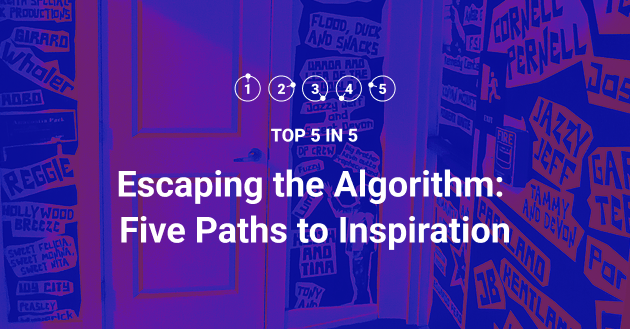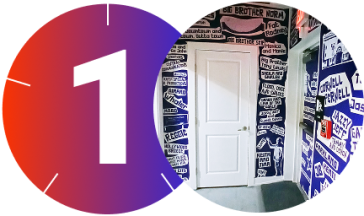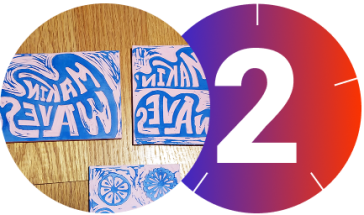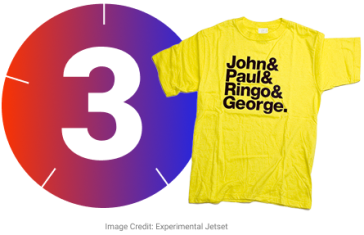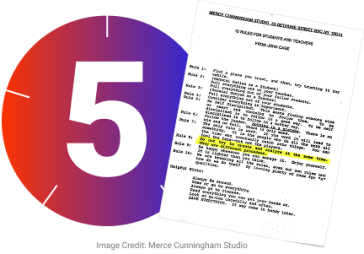Loide Marwanga, Associate Creative Director shares 5 unique ways to find inspiration in the age of algorithms and generated content
Creatives look for inspiration everywhere, but mindless scrolling and media consolidation has made it very easy for us to rely on the same online sources as everyone else: Instagram, Pinterest, “For You” feeds, etc. Algorithms in social media have become very good at producing an aesthetic sameness across all the results to your queries. Seeing the same visuals clutter up your feed (including ads and AI slop) is not inspiring. Here are a few actions I’ve been taking to keep fresh ideas flowing into my work.
1. Taking control of my inputs
To escape the sameness, I’ve been getting out into the real world and documenting what I find. A recent trip to the Go-Go Museum in Southeast DC got me excited about bold typography in a “Roll Call” installation that wallpapers their small space with Go-Go artist names.
I have also found online sources that facilitate intentional exploration instead of thoughtless scrolling and pinning. I particularly enjoy perusing visual archives like the Public Domain Archive, whose “Infinite View” helps my mind wander and make its own connections.
2. Switching mediums
When it feels like I’m repeating the same ideas (mine or others’), I try to approach design problems from an oblique angle. Everything I made on the computer for a recent project couldn’t beat what was already being produced by the rest of the design team, so I went looking for fresh ideas in serendipity. I dug up my linoleum sheets and started carving.
Working in unfamiliar or unexpected media, particularly physical ones, allows me to let go of my perfectionism and leverage chance and randomness as a tool to make something new and exciting. My linocut sketches didn’t produce anything useful, but that time wasn’t wasted: I refreshed an old skill and completed visual research that might benefit other projects.
3. Introducing new constraints
Designers find creative solutions when faced with constraints, in a brief or otherwise. One example that’s really inspired me is Experimental Jetset, a studio that worked only in Helvetica and, for a time, only in black and white. The variety of clients and work they were able to tackle with that seemingly unwise constraint impressed me, particularly their 2013 Whitney Museum rebrand.
I’ve been experimenting with self-imposed constraints to beef up my creative problem-solving skills. I recently canceled my personal Adobe CC and Stock subscriptions so I could push myself out of its walled garden and consider other ways to design documents and generate imagery. I’m even considering downgrading my personal laptop to a Lenovo ThinkPad and booting it up with an old Adobe CS6 CD. I hope that simplifying my tools will help me focus on the strength and effectiveness of the designs I make with them: a strong design rarely needs a computer to make it sing!
4. Dig into your collections
I love printed ephemera of all types — even the patterns on the inside of security envelopes get me excited when I notice a new one. I keep a collection of random paper and other bits I’ve acquired over the years in a small basket. When the basket is full, I dig through it and look for inspiration: a color, a pattern, a typeface, an ink treatment, a paper texture. I toss anything that no longer speaks to me.
I’ve also recently found a great method that helps me collect bits of text and other inspirations into my pocket journal: a commonplace book. I chose a theme to start, and as I surf the internet, read a book, or hear a speech that I like or is relevant to the theme, I take the time to write it down long-hand and index it in my journal. When I’m on the bus or bored, I flip through it and am sometimes inspired to write or sketch my own reflections.
Both collections are ongoing, irregular, and mean nothing to anyone other than myself, but they’re unique fonts of inspiration no one else has access to!
5. Untangle your processes
The creatives Sister Corita Kent and John Cage wrote, “Do not try to create and analyze at the same time. They’re different processes.” In my professional life, I’ve developed a lot of analyzing, editing, and presentation skills. Unfortunately, it’s sometimes led me to lose focus on my creative skills, skills that rely on entirely different mental pathways. Like multi-tasking, you can do both at the same time, but to the detriment of both; the human brain works best when it can mono-task!
To refocus my creative skills, I’ve been untangling my creative tasks from my “editing” tasks by stacking them on my calendar in a way I hope helps me focus on one process at a time. For example, mornings are for “creating” tasks, such as layout or drawing, and afternoons are for “analyzing” tasks, such as giving feedback or making presentations.
My Top 5 for fresh ideas change all the time, but so far, these five methods have helped me prioritize keeping my brain agile, inspired, and ready to make some fresh creative work!
About the Author: Loidë Marwanga is an Associate Creative Director at MarCom Group. They are based in Washington DC, and joined the team in 2023.


